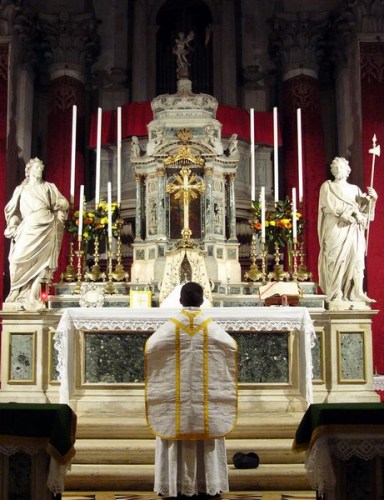
Where do traditional Catholics go from here? Of course, all Catholics should be ‘traditional’, in the sense of preserving, living by and handing on our great Tradition, as one of the pillars of revealed truth, along with Scripture.
But traditional may also refer specifically those who prefer the usus antiquior, or the TLM, and we may also extend the term to those who prefer chant, Latin, the pipe organ, solemnity, ad orientem, solid and doctrinal homilies, cassocks, Communion on the tongue, all of which are consistent with our Tradition; and no to altar girls, liturgical dancing, guitars and bongos, soporific sermons, syncretism, glad-handing and ex tempore liturgy, all of which are inimical to it.
A significant portion of the Church, including the higher members of the hierarchy, seem determined to impose the latter and abolish the former. Channeling their inner Voltaire, they seek to ecraser l’infame, ‘crush the infamous thing’, in this case, the Latin Mass, and anything connected thereto, from lace to Latin.
Since we are, as Catholics, in theory, bound in obedience to the Magisterium – ‘religious submission of mind and will’ and all that – what might we do?
First, a bit of history. The Novus Ordo Mass was promulgated in Advent of 1969, in its editio typica Latin version, rarely ever said, then and now. Priests, who had been saying the Latin Missal of 1962, quickly switched to the vernacular, along with many other innovations.
Archbishop Marcel Lefebvre, who was at the Council, saw the drift of things, which prompted him to found in 1970 the Society of Saint Pius X, with the intent to preserve the traditional liturgy and practices of the Church. The reader may peruse the canonical legal history following Lefebvre’s decision, on June 30th, 1988 to consecrate four of his priests as bishops without papal mandate, in fact, directly contrary to the orders of Pope John Paul II, who had agreed to ordain one bishop for the society. One wonders what might have happened if Archbishop Lefebvre had agreed to this. But he did not, and went his own way, for better or worse. (See also here for an account of Mr. Vere’s journey out of the SSPX)
Three days later, July 2nd, Pope John Paul II, promulgated Ecclesia Dei, stating that this was legally and canonically an act of schism, which carried the penalty of excommunication, latae sententiae, applied to Lefebvre and the four bishops whom he ordained. Without delving into the consciences of those involved, Pete Vere argues persuasively in the aforelinked article that this sentence was justified, and that other paths could have been followed by Lefebvre. Which is sort of where we’re at now.
In the same document, Pope John Paul extended permission for priests to say the Traditional Mass (but still under episcopal oversight). Two weeks later, on July 18th, 1988, with full papal approval, the Fraternity of Saint Peter (FSSP) was founded, made up primarily of disaffected SSPX members who did not want to follow Lefebvre into schism, or at least disobedience. The primary mission of this society was much like the SSPX, to preserve and offer the Traditional Mass, but in full union with the Church and the Pope, and they have done incalculable good in the world. Other Societies and Orders have followed suit, dedicating themselves to the usus antiquior in their prayer and liturgy.
Twenty years later, on July 7th, 2008, Pope Benedict promulgated Summorum Pontificum, which extended even further allowance of the traditional Mass, with full freedom for priests to say the Mass in private, and wide allowance also in public liturgies (but, again, the latter in line with episcopal oversight).
This inaugurated what some have called the ‘Benedictine Peace’, even if it may only have been a band-aid over a much deeper division and animosity.
Then, last year, Traditionis Custodes hit like a liturgical nuclear bomb on July 16, 2021 (the memorial of Our Lady of Mount Carmel), followed up by the replies to the ‘dubia of December’, all of which severely restricted the Traditional Mass, and even more so most of the sacraments of the usus antiquior. The details may be easily found, but suffice to say, the peace is over, as the current leadership of the Church, as we said at the beginning, seeks to forcibly remove access to any preconciliar liturgy.
So, what now?
I can only offer some thoughts, that I hope help the reader’s conscience to make up his own mind:
We must avoid a state of anarchy in the Church, striving to work within the law. Recall the conversation between Thomas More and his son-in-law Roper, who sought to ‘get’ King Henry by any means possible. Thomas, on the other hand, advocates caution, even for the Devil himself:
Roper- Now you give the Devil benefit of law!
More– Yes, what would you do? Cut a road through the law to get after the Devil?
Roper– Yes. I’d cut down every law in England to do that.
More– And when the last law was down, and the Devil turned on you…where would you hide, Roper, the laws all being flat? This country is planted with laws from coast to coast, Man’s laws, not God’s, and if you cut them down, and you’re just the man to do it, do you really think you could stand upright in the wind that would blow then?
What applies to civil society applies even more so to the Church, which is ‘thick with laws’. And that is just the point. For if Traditionis stands on shaky legal ground, it will be undone in due time by the very laws of the Church herself, built up and codified over a millennium and a half. No Magisterium – whose task is primarily to preserve tradition – can undo that. We must be patient, and not hasty, or flail. That would be just what the Devil wants. If schism there must be, let it not be caused by us.
At the same time, we cannot just cave in, for we too have a duty to preserve and hand on the Church’s traditions, teachings and liturgical treasures, but all in due order, with prudence. A useful distinction is offered by Saint Thomas: When faced with an unjust or unreasonable law, we may act praeter legem, ‘beside the law’, but still in keeping with the mind of the original lawmaker and the higher authority, interpreting the less clear with the more clear, and the less authoritative by the more authoritative. But we must take great caution in acting contra legem – ‘against the law’, directly defying a specific order from an authority. As Thomas says, we should avoid scandal and disturbance – a rebellious spirit fomented in our souls, or an anarchic breakdown of order. (For more on law and obedience, please see here).
The history of the Church is littered with factions and sects, from the Marcionites of the 2nd century to the ‘Old Catholics’ of the 19th. We cannot make our own church, or a church within the Church.
The purpose of liturgy is not for its own sake, but ultimately for our good. God does not need our worship and He asks such from us only so that we grow in love for Him, in goodness of life, and so prepare ourselves for eternity. Lex orandi, lex credendi, lex vivendi. We live as we believe, and we believe as we pray. Prayer comes first, and our modus orandi should always make us more virtuous. If Liturgy itself starts leading to bitterness, resentment and judgementalism, we’ve sort of lost the plot.
To this end, there is no ‘perfect Liturgy’, only the more or less perfect. Is the 1962 Missal ‘better’ than that of 1955, or of 1570, as promulgated by Pope Pius V, and said by Philip Neri and Ignatius of Loyola? What of the two dozen or so other rites in the Church? One may agree that the revisions of the Novus Ordo went too far and were too radical, especially as it is often celebrated in praxis. Even so, it can still be prayed reverently, and often is, with much grace derived therefrom. The new Mass will be the norm for some time to come.
Two pertinent caveats are offered by the Congregation for the Doctrine of the Faith, under Josef Ratzinger, in an Instruction, Some Aspects of Christian Meditation, promulgated on October 15, 1989 (on the feast of Saint Teresa of Avila). Although focused on private prayer, the principles also apply to the public prayer of the Liturgy.
The first warns against a type of ‘Messalisanism’, that for prayer to be good, it must make us feel good. There is the obvious form of this, in the happy-clappy Masses and gushy emotionalism found in too many parishes, and especially in the fringes of the charismatic movement. But there is also a subtler form of this tendency, what might be called a hyper-aestheticism, an over-emphasis on beauty. If everything – music, architecture, sermon – is not ‘just right’, well, we will just ‘not go’, starving ourselves of the grace of the sacraments.
The other tendency is a kind of pseudo-Gnosticism, an over-emphasis on technique and form. Not that these are not important – they are, and vitally so – but we should be careful not to off-load our spiritual lives to an external liturgical participation, or count with gimlet eye every cross and genuflection of the priest, or the women in the pews without veils.
Attending Mass should be beneficial to our minds, souls and bodies, but this will often require tolerating what is less than perfect, and suffering in union with our Lord. It’s fine and good if we find Him in a glorious gothic cathedral in a solemn high Mass with a perfectly blended schola, or even if we are blessed enough to live within chanting distance of a parish that maintains proper liturgical solemnity, the FSSP, Anglican Ordinariate, or any of the Eastern rites, par example. But there are problems and difficulties and human foibles, imperfections, sins wherever we go; perfection can’t be found on this side of heaven.
We should take comfort that He’s also there in all the workaday Masses across this fair land, in squat, circle-in-the-round, unappealing churches, amongst warbling septuagenarian sopranos and lackadaisical priests going through the motions. God works, ex opere operato, in ways we might not expect, nor even desire.
There are of course limits – witness specimen A from Father Z – and it seems, alas, that such abuses are becoming not only more common, but more acceptable, as our liturgy, along with the rest of civilization, slides slowly off a cliff.
We live in strange days, and all I can say is that as we work and wait for things to be purified – and they will be – we should continue to worship, to receive the sacraments and the graces they offer, as devoutly as our situation, and our conscience, permit, and even urge. Do you what you can to make your parish traditional, by your dress and decorum, joining the choir, dialoguing with the priest, by prayer and sacrifice. Incremental improvements do great good over time.
I know not what the future holds – Mass in whatever metaphorical catacombs loom? But we have certain hope that truth, goodness and, dare I say, even beauty will in some way prevail. Have patience, trust and fear not, for our redemption is near at hand.










